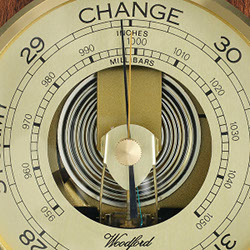 It’s not uncommon for those with chronic joint pain to feel more pain and stiffness when the weather changes. It may be tempting to be skeptical when an elderly relative predicts that it will rain tomorrow because based on their joints, but it turns out they may be right. Essentially, our joints can sometimes act as human barometers.
It’s not uncommon for those with chronic joint pain to feel more pain and stiffness when the weather changes. It may be tempting to be skeptical when an elderly relative predicts that it will rain tomorrow because based on their joints, but it turns out they may be right. Essentially, our joints can sometimes act as human barometers.
It’s not actually the cold, snow or rain that causes an increase in joint pain, but rather a change in the barometric pressure. Robert Jamison, PhD, a professor at Harvard Medical School and chief psychologist at the Pain Management Center at Brigham and Women’s Hospital in Boston, and several colleagues performed experiments with chronic pain sufferers to investigate this phenomenon. The resulting study reported that “67.9 percent of the people surveyed responded that they were sure changes in the weather had an effect on their pain. Most of the patients reported that they can feel a change in their pain before rain or cold weather occur.”
Jamison likens the joints to a balloon. “When a balloon is inflated, it has the maximum inside and outside pressure. High barometric pressure that pushes against the body from the outside keeps tissues from expanding.” But when the weather changes, the barometer drops, reducing atmospheric pressure and allowing tissues to swell. This can put increased pressure on the nerves that send pain signals. “It doesn’t take much expansion or contraction of tissue to affect a pain trigger,” Jamison adds.
Moving to a warmer climate unfortunately will not help the problem in most cases. Jamison says “There’s no heaven on earth. If you have awful back or neck pain … there’s a good chance that that pain will travel with you.” According to Jamison’s research, there is no area of the country where people experience less pain. The patients with chronic pain who lived in San Diego reported just as much pain as their counterparts in Boston.
So what can you do? Well the problem doesn’t just lie in the reading on the barometer. If that were the case, everybody would feel pain as the pressure changed. There has to be an existing problem with the joint to begin with that then reacts to the change in pressure. A person whose body has joints that are functioning the way they are supposed to is able to tolerate these small changes in pressure and adapt to the any small swelling to might may occur as a result. Someone whose joints have a problem or are not functioning properly will not be able to tolerate or adapt to the swelling that may occur and this causes pain. The best option, see a chiropractor and find out if your pain is due to dysfunction in a joint. This can include spine, knees, elbows and just about any joint in your body.
You may not be able to avoid the weather but hopefully we can help you avoid the pain.

Dr. Jason Schluter is a Chiropractor in Tulsa, OK at Schluter Chiropractic.
Schluter Chiropractic is conveniently located off Memorial Drive in Tulsa, Oklahoma and provides quality chiropractic care to Tulsa and the surrounding areas.
To schedule an appointment, call (918) 664-3571 or visit www.DrSchluter.com.





